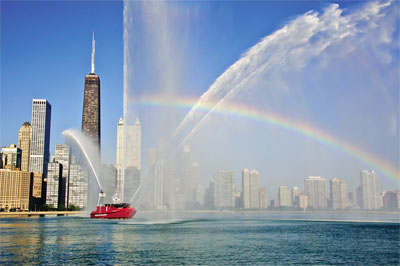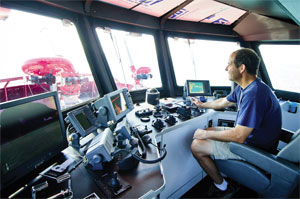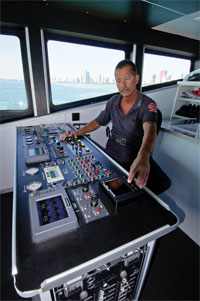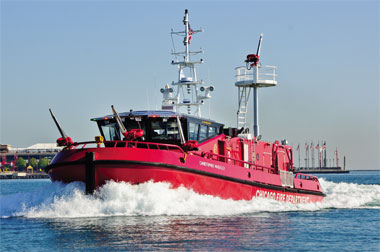Ever vigilant, the 92-foot fireboat Victor L. Schlaeger and its full-time crew have served the city of Chicago well. Always ready at its berth between Navy Pier and the city's water filtration facility, Schlaeger, designed and built in 1949, has been the Chicago Fire Department's prime marine firefighting asset.
But response technology has changed a little in the last 62 years, and the city now needs not just a firefighting vessel but a multipurpose rescue platform as well. So the fire department looked to Vancouver, B.C.-based Robert Allan Ltd. to design a replacement — a vessel that would comply with modern standards for fireboats, but one that could also deal with the challenges of life on the edge of Lake Michigan: lake ice, low bridges and shallow waters.
 |
|
Christopher Wheatley throws up curtains of water against a classic Chicago backdrop, the Lake Michigan waterfront. |
The solution comes in the form of a firefighting vessel of a unique design launched in April and delivered in early summer. Named in memory of Chicago firefighter Christopher Wheatley, who lost his life on active duty last year, the boat was built by Hike Metal Products of Wheatley, Ontario (the names Wheatley are purely coincidental). It's one of several fireboats built in Canada for U.S. cities under a free trade agreement that opened up the market segment to Canadian shipyards.
As a design firm, Robert Allan is known for its state-of-the-art tugs and specialty vessels, and its design statement for Christopher Wheatley illustrates the difficulties of this assignment.
"The fireboat was designed and built to operate year-round in Lake Michigan, the Chicago River and surrounding harbors, which includes up to one inch of first-year ice," the designer said.
"The combination of a very shallow operating draft and an equally limiting air draft presented a significant design challenge, especially regarding weight estimation. If too heavy, the vessel would near the bottom of the shallow river; if too light, it would run afoul of the numerous low-height bridges that grace the Chicago River through downtown Chicago."
Dave Hewstone, a project manager for Hike Metal Products, said that to handle ice and shoal water the hull shape has a spoon-like profile that makes the bow shape virtually indistinguishable from the stern. An ice strip of additional steel hull plating was added above and below the waterline around the entire vessel, and heavy skegs were added fore and aft to break ice and to give some directional stability in view of the hull shape. Hewstone said the vessel's shallow draft, just over 7 feet, could be adjusted as needed with water ballast.
Unlike Schlaeger, Wheatley is configured as a "day boat" with a fully equipped galley, but without a full-time crew. Sacrificing crew quarters created room for a dedicated EMS space directly accessible from the main deck, additional EMS space below deck, and a decontamination shower.
The aft deckhouse, which like the pilothouse is all aluminum, provides storage for life rafts and life jackets while additional storage areas contain scuba and SCBA gear along with hoses and other equipment. For ease of access these areas are reached via large roll-up doors on either side of the vessel.
 |
|
Bill Schmidt, one of two civilian pilots, said the fireboat handled well on its delivery trip from the Ontario yard that built it, and he looks forward to seeing what it can do under wintry conditions on the lake. |
Firefighting equipment includes four Stang firefighting monitors: center forward (6,000 gallons per minute), forward port and starboard (3,000 gpm each), and aft, where a 3,000 gpm monitor is mounted on a hydraulically operated mast built by Hunger Hydraulics of Rossford, Ohio. The mast can raise the monitor 30 feet above the waterline.
Additional firefighting capability includes an array of port and starboard hose manifold connections — nine each — and a forward array of four connections.
The firefighting pumps consist of two independent CAT C32 diesels rated at 745 kW at 1,800 rpm driving an FFS model SFP250 x 350 fire pump rated at 7,000 gallons per hour at 150 psi.
For propulsion there are also a pair of CAT C32 high-speed diesels rated at 1,081 kW each at 2,300 rpm. Each engine drives a 54-inch fixed-pitch propeller through a ZF model W4610 reverse-reduction gearbox. For auxiliary power there are a pair of CAT model C4.4 diesel gensets.
The boat is equipped with a Maretron vessel monitoring and control system that reports on all operating systems and will also warn of high bilge water, smoke and fire through external hailers.
Wheatley's pilothouse is a true command center. It is laid out with distinct control centers, two for navigation and vessel control (including AIS, sat nav and radar) and one each for machinery controls and communications. It is also designed for maximum visibility.
Lt. Tony Yuhas, one of three Chicago Fire Department officers aboard the vessel, points out that the boat is equipped with a wide array of sophisticated communications electronics as well as video monitors on deck and below. The boat is also equipped with an infrared camera that can transmit real time images to a shoreside location. Yuhas said that aside from starting the gensets, everything aboard the boat is controlled directly from the pilothouse — critical for speed and efficiency when getting underway in response to a call.
 |
|
Engineer Bill Bailey at the Stang monitor control and fire pump console. |
A regular crew for Wheatley is made up of a civilian U.S. Coast Guard-licensed pilot, one firefighter, two firefighter/engineers and one officer.
Bill Schmidt, one of Wheatley's two civilian pilots, said he's very pleased with the boat. Despite its unusual hull design, he said, it tracks very well. On the delivery trip from Canada, Schmidt said, the boat handled heavy lake seas and gale force winds without any problem.
Designed as a multipurpose response vessel whose primary mission is firefighting, Wheatley is also asked to perform some unusual tasks, such as spraying cooling water on the city's old iron bridges when summer heat causes the metal to expand and prevents them from closing properly.
Schmidt said he looks forward to the winter, when he believes that the vessel's icebreaking abilities will really shine. "I think that she'll be a real animal out there on the ice."

